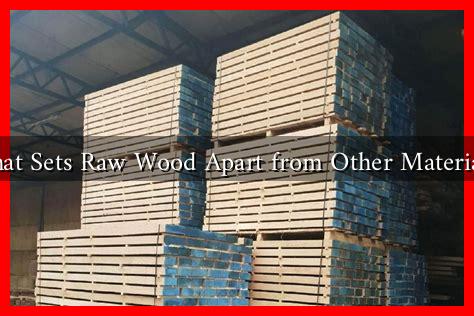-
Table of Contents
What Sets Raw Wood Apart from Other Materials?
Raw wood has been a fundamental material for human civilization for thousands of years. Its unique properties and versatility make it a preferred choice in various applications, from construction to furniture making. But what exactly sets raw wood apart from other materials? This article delves into the distinctive characteristics of raw wood, comparing it with alternatives like metal, plastic, and composite materials.
The Natural Aesthetic Appeal
One of the most significant advantages of raw wood is its natural beauty. The grain patterns, colors, and textures of wood create a warm and inviting atmosphere that synthetic materials often struggle to replicate. This aesthetic appeal is particularly valued in interior design and furniture making.
- Unique Patterns: Each piece of wood has a unique grain pattern, making every item distinct.
- Warmth and Texture: Wood provides a tactile experience that is often more comforting than cold metals or plastics.
- Versatility in Finishing: Wood can be stained, painted, or left natural, allowing for a wide range of design possibilities.
Environmental Sustainability
In an era where sustainability is paramount, raw wood stands out as a renewable resource. When sourced responsibly, wood can be a more environmentally friendly option compared to materials like plastic or metal, which often require extensive energy for production and are not biodegradable.
- Carbon Sequestration: Trees absorb carbon dioxide, helping to mitigate climate change.
- Biodegradability: Unlike plastics, wood decomposes naturally, returning nutrients to the soil.
- Renewable Resource: With proper forest management, wood can be harvested sustainably without depleting resources.
Durability and Strength
While raw wood is often perceived as less durable than metals, it possesses remarkable strength and resilience when properly treated. Certain types of wood, such as oak and teak, are known for their durability and resistance to wear and tear.
- Load-Bearing Capacity: Wood can support significant weight, making it ideal for structural applications.
- Resistance to Environmental Factors: Treated wood can withstand moisture, pests, and decay, extending its lifespan.
- Flexibility: Wood can bend under pressure without breaking, a property that is advantageous in construction.
Insulation Properties
Raw wood also excels in thermal and acoustic insulation. Its cellular structure traps air, providing excellent insulation against heat and sound, which is a significant advantage in building construction.
- Energy Efficiency: Wood’s insulating properties can reduce heating and cooling costs in buildings.
- Sound Absorption: Wood can dampen sound, making it ideal for spaces requiring noise control.
Case Studies and Real-World Applications
Numerous case studies highlight the advantages of using raw wood in various applications. For instance, the use of cross-laminated timber (CLT) in high-rise buildings has gained popularity due to its strength and sustainability. The Brock Commons Tallwood House in Vancouver, Canada, is a prime example, showcasing how wood can be used effectively in modern architecture.
According to a report by the Forest Products Laboratory, buildings made from wood can have a lower carbon footprint compared to those made from concrete or steel, further emphasizing the environmental benefits of using raw wood.
Conclusion
Raw wood stands out from other materials due to its unique aesthetic appeal, environmental sustainability, durability, and insulation properties. As society increasingly prioritizes sustainable practices, the demand for raw wood is likely to grow. Whether in construction, furniture making, or design, raw wood offers a blend of beauty and functionality that few materials can match. By understanding its advantages, consumers and builders can make informed choices that benefit both their projects and the environment.
For more information on sustainable wood sourcing, visit the U.S. Forest Service.

